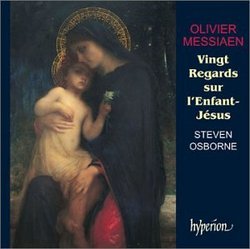An astonishing recording
John H. Pendley | the beautiful mountains of north Georgia | 10/18/2005
(5 out of 5 stars)
"Steven Osborne's recording of Messiaen's Vingt Regards sur l?Enfant-Jésus gets to the heart of the matter. It realizes the two-fold nature of Messiaen's masterpiece; and in doing so, it fully reveals this music as not only an enormously intellectual challenge but as an immensely powerful emotional and spiritual one as well.
That this music poses a great conundrum for the pianist hadn?t impressed itself upon me so vividly until I heard this recording: it is both very passionate and very spiritual. This is exactly as it should be, since its subject is the infant Jesus, the Son of God. Messiaen made this music for Him, believing that mankind would never have known the deep spiritual truths if the Son had not become incarnate: God?s mind is too mysterious for man to know directly. For Messiaen, the passion inherent in being human and the spirituality of the Godhead came together in the Christ he worshiped. And so the two paradoxical elements are one in his music. Osborne communicates these two elements as I haven?t heard them before now.
This duality is evident in the very first piece in Vingt Regard, ?Regard du Père,? ("Gaze of the Father"). The movement is marked Extrêmement lent. Mystérieux, avec amour. My previous standard in Vingt Regards has been Pierre-Laurent Aimard, who is rather matter-of-fact in this movement, his phrasing regular. His dynamic range varies from about mezzo piano to mezzo forte. Osborne?s approach to the piece is quite different. It is much slower. In fact, it is two full minutes slower! (Aimard, 6:10; Osborne, 8:10) Its dynamic range extends from about mezzo piano to some of the most amazing pianissimo recorded sounds I have heard, with perhaps one brief instant of mezzo forte. And here, I think that we are approaching the point at which all this technical business intersects art. We are listening to Messiaen?s aural picture of God the Father viewing his mortal Son, and Osborne?s vision spreads out at great length and is very hushed; the great chords of the God the Father theme (to be heard throughout Vingt Regard) impress the listener as imponderable and immensely tender. Aimard?s playing of this music, as much as I?ve enjoyed his recording in the past, now seem to miss the mark. Remember Messiaen?s directions: extremely slow, mysterious, with love. Osborne makes the music sound no less than that, and a great deal more, besides. The music has a sensuous, mesmerizing beauty. From the opening bar, Osborne?s use of the pedal causes chords to blur together. This, combined with Messiaen?s dissonances, causes this unworldly experience to seem very beautiful, not unlike the sensation of being beneath the sea. But that mixes metaphors. There is never any doubt that we are in the presence of the awe inspiring.
The fifth piece ?Regard du Fils sur Fils,? ("Gaze of the Son upon the Son") is another case that speaks to the same point. It contains some of Messiaen?s? famous bird music. Here Aimard?s birds, however beautifully they may sing, are earthbound creatures. Under Osborne?s spell, they sing a divine music. Osborne?s wonderful lightness of touch simply transforms this music into something unearthly. (This simply must be heard to be believed.) Again, the theme of God the Father wafts quietly through the left hand; but now, bright creatures, drunk on heavenly light, flutter in the right.
Steven Osborne performed Vingt Regards in Wigmore Hall, London, on January 5, 2000. That was two hours, ten minutes, of exhausting music making, without intermission. I?d really love to have been there. Failing that, I have this magnificent recording. It is full of the kinds of revelations I?ve described. While I have come back to Aimard?s Vingt Regards sur l?Enfant-Jésus regularly, because it was the finest recording of the piece and because it is filled with amazing pianism, I play Steven Osborne?s recording often?sometimes repeatedly?because it allows me to experience the essence of the music, because it is beautiful and awe inspiring, and because I love it.
Most warmly recommended.
"
First place among Vingt Regards sur l'Enfant-Jesus
Kenneth J. Luurs | Oak Park, IL USA | 10/31/2002
(5 out of 5 stars)
"This is a work which inspires passion - one way or another. Like the Goldberg Variations, it attracts pianists seeking an Everest to climb. Of the CD versions of this work, I believe this recording is the finest now available. The colors achieved by Osborne, the delicacy of sound, the tone of the instrument, even the recording quality itself all lend itself to a superior recording. The Aimard recording is good - but cooler. The opening work, "Regard du Pere" really sets the mood for the entire performance. It is hauntingly beautiful...sound rising from nothingness...exquisite tones...Aimard plays quicker and cooler -- Osborne's music is more sensual...captivating.All-in-all, this is a performance which may win you over even if you've never liked this work. It is that good."
Osborne's Kapustin was good, but this is off the map...
Kenneth J. Luurs | 05/10/2003
(5 out of 5 stars)
"Let me start by saying this release is one of the best piano discs I have ever heard. The music, performance, sound, and presentation are all superlative.I had enjoyed Osborne's Kapustin recordings (though I preferred Hamelin's live versions of the same material), but his newer Messiaen disc completely stunned me. Most obviously, Osborne has suddenly become a master colorist. I can't imagine a more immediately effective performance or recording of this material. For me, Osborne's Messiaen disc has quickly become as cherished as Richter's 1958 Sofia Recital, Hamelin's Wigmore Hall Recital, or Hough's Mompou recordings. Please do yourself a favor and invesigate."


 Track Listings (1) - Disc #1
Track Listings (1) - Disc #1